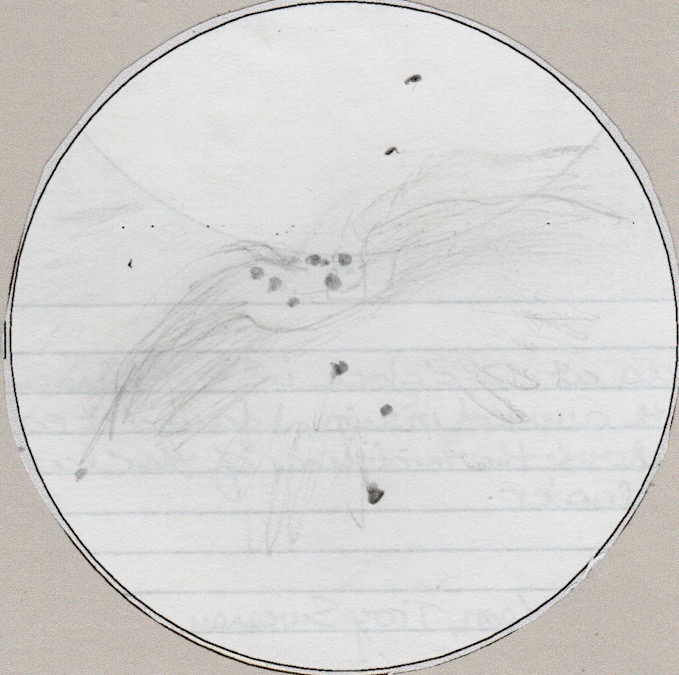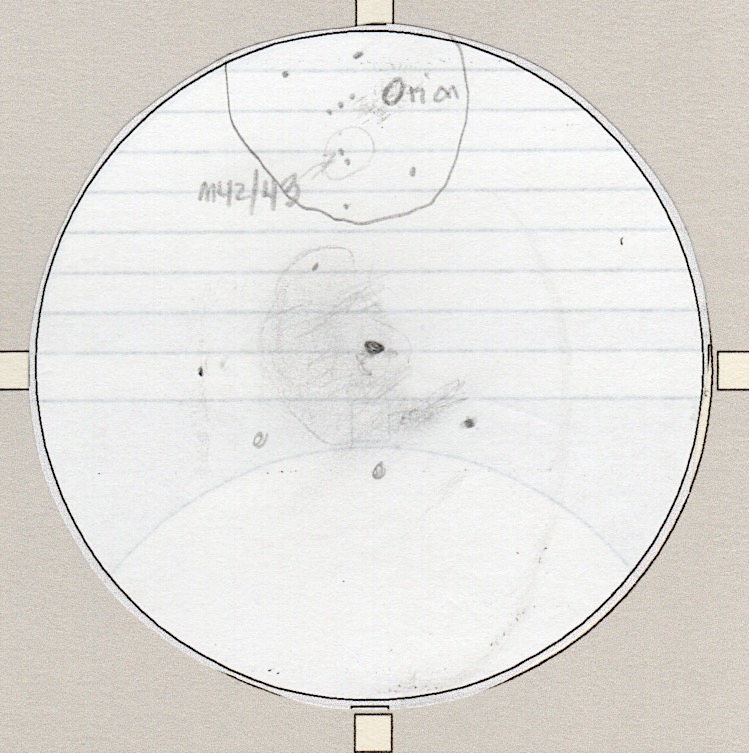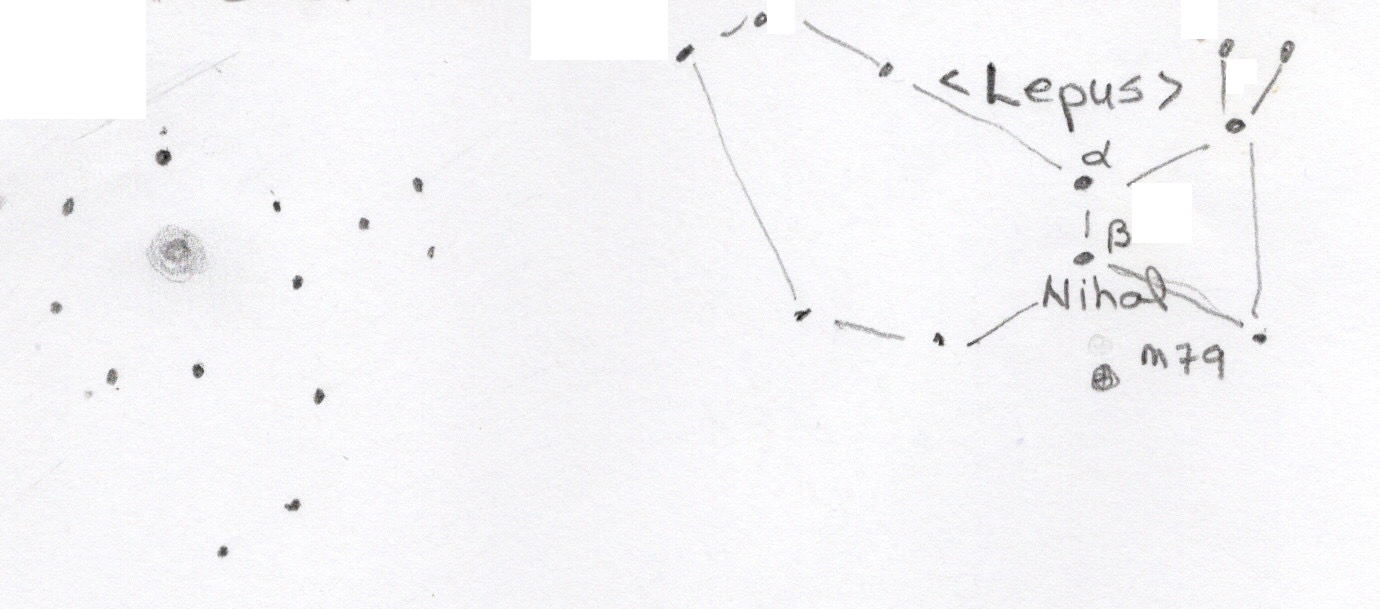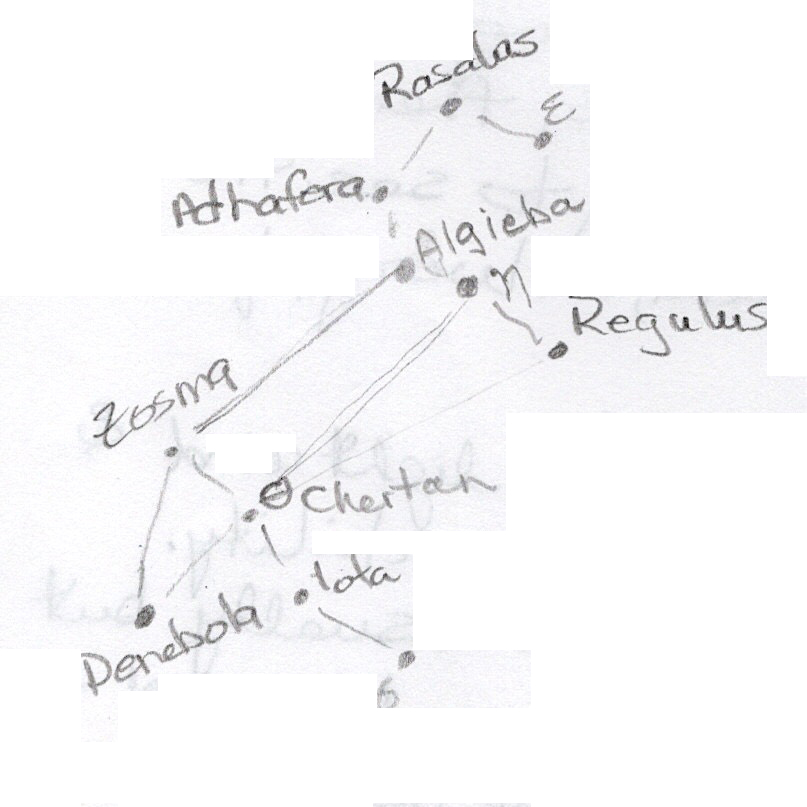Constellations: Canis Major, Cassiopeia, Leo, Lepus, Orion, Pisces, Taurus, Ursa Minor
Asterisms: Big Dipper, Winter Circle, Winter Triangle
Stars: Aldebaran, α Arneb, Alrescha, Betelgeuse, Castor, Capella, δ Ceti, Gomeisa, α Menkar, Mira, β Nihal, β Kochab, Pollux, Procyon, Rigel, Sirius
Clusters: Melotte 25/Hyades, NGC 1981
Planet: Venus
Messier Objects: M41, M42 (Orion Nebula), M43 (De Mairan's Nebula), M79
Location: SCO
Date: 2020-02-21
Time: 6:30 PM - 11:00 PM ADT
Instruments: Visual, Binoculars 10x42 IS, 16" Dobsonian telescope
Eyepiece: Tele Vue 40 mm Plössl
Transparency: Good (3) until around 10:30 PM
Seeing: Good (3) until around 10:30 PM
Temperature: 1° C to -2° C
SQM: 21.08 - 21.15
Could not Locate:
Monoceros, M1, M50, M52, M65, M66, M95, M96, M103, M105
NGC 869/NGC 884
At SCO with Jerry and Peter Hurley. Slight breeze. No clouds.
Big Dipper Asterism in Ursa Major, Ursa Minor
Time: 7:45 PM
Equipment: Visual
S&T Chart: 31, 32, 33, 43, F
The Big Dipper was in essence standing upright with its bowl facing W-SW. All 7 stars were visible naked eye.
The Ursa Minor 'bowl' was below Polaris as it was two nights ago. I could locate 5 of the 7 stars - Anwar al Farkadain and Alifa al Farkadain (the two stars closest to the handle) were barely visible at 10:30 PM due to diminished sky conditions.
Orion, M42, M43
Time: 8:17 PM
Equipment: Visual, Binocular
S&T Chart: 14, 16, B
Easily located all the major stars and nebula in Orion. Could easily see M42, M43 and NGC 1981 in Orion's 'sword' below his belt naked eye. I also used my binoculars to have a closer look. I used the 16" Dob that had been poorly aligned so had to slew to find M42 and M43.
|
M42 (Orion Nebula) was located naked eye and with binoculars. However, it filled the Dobsonian FOV! There were 3 stars in a triangular formation (very tight) and 3 more in a linear arrangement. The "wings" spread from side to side; there were 3 very bright stars in the nebulosity and a couple just outside where the triangular star formation was located. All in all, very impressive. Also refer to Messier Catalogue - M042 (Orion Nebula, NGC 1976) - February 23, 2020. |
M42  |
M43  |
M43 (De Mairan's Nebula) was located naked eye and with binoculars. In the eyepiece of the Dobsonian, the nebulosity was like half of a ball with a very bright star about half way along the "cut" edge. There were 4 stars just outside the rounded edge that were bright. Also refer to Messier Catalogue - M043 (De Mairan's Nebula, NGC 1982) - February 23, 2020 |
Otherwise, Orion took up a large part of the southern sky and we watched him over the course of the evening go from S-SE to S-SW. M42
Taurus, Hyades/Melotte 25, Cetus, Venus
Time: 8:35 PM
Equipment: Visual, Binocular, Telescope
S&T Chart: 14, 15, A
Identified Aldebaran and the V-shaped open cluster of the Hyades naked eye. Also used binoculars to view the gorgeous Hyades! Attempted to find M1 (Crab Nebula) near ζ Tauri but could not find it naked eye, with binoculars, nor the 16" Dobsonian.
To locate Cetus, I followed down from the Hyades to λ and ξ to Cetus's head and there found Mira.
The very bright Venus was high in the sky, west of Cetus in Pisces.
Lepus, M79
Time: 9:23 PM
Equipment: Binocular, Telescope with 40mm Plössl eyepiece
S&T Chart: 16
Lepus was easily located naked eye below Orion and was able to identify all the major stars of the constellation. With binoculars, used Arneb and Nihal as the stars to measure distances; they were approximately 1 FOV apart in my binoculars. Went 1 FOV below Nihal and located M79 - a small dense cluster that had a circle of stars around it.
I then used the 16" Dobsonian, slewing from M43 to M79. Found a small compact grey fuzzy with a bright centre and a nebulous-looking but probably stars are packed around the central core. What made this so interesting (and gave me an "oh wow" moment) was the darkness surrounding this nebula that was ringed with 8-9 bright Gaia-labelled** stars, just like a stellar outline of the space taken by the cluster. Really cool! Also refer to Messier Catalogue - M079 (NGC 1904) - February 23, 2020.

** Gaia is an ambitious mission to chart a three-dimensional map of our Galaxy, the Milky Way, in the process revealing the composition, formation and evolution of the Galaxy. Gaia provides unprecedented positional and radial velocity measurements with the accuracies needed to produce a stereoscopic and kinematic census of about one billion stars in our Galaxy and throughout the Local Group. This amounts to about 1 per cent of the Galactic stellar population.
Monoceros, M50
Time: 9:45 PM
Equipment: binoculars, 16" Dobsonian
S&T Chart: 25, 27, E
I was using the Dobsonian to locate these two objects, despite its poor polar alignment. Used the controller to move around this area of the sky but to no avail. The seeing had greatly diminished at this point so did not make an attempt to identify the stars in the constellation nor to locate M50 via Canis Major.
Canis Major, M41/Little Beehive
Time: 9:50 PM
Equipment: Visual, Binocular
S&T Chart: 27
The temperature had dropped to -4° C and was cool but the breeze had dropped. Stars of the 'big dog' were as evident as they were two nights ago but they were not as bright. Used my binoculars to very easily locate M41.

|
Leo Time: 10:00 PM Equipment: Visual S&T Chart: 34, 35 I could actually see the major stars in the constellation. This was helpful as I was attempting to locate 5 Messier objects in Leo: M65 and M66 between Chertan and Iota; M95, M96 and M105 just under Leo's mid-belly. Unfortunately, at this time of the evening, the seeing had diminished. Could not find them naked eye with the binoculars over a 30-45 minute period, nor the 16" Dobsonian with 40mm Plössl eyepiece. Disappointing to say the least. |
Cassiopeia, Perseus
Time: 10:20 PM
Equipment: Visual, binoculars, telescope
S&T Chart (Cassiopeia): 1, 3, 72
S&T Chart (Perseus): 2, 13
The seeing and transparency had diminished; stars not quite as bright as compared to what they were earlier. The constellation was identifiable since 8:00 PM or so. I wanted to look for M52 and M103 using binoculars and the telescope. Unsuccessful on both counts.
Located Perseus and many of its stars. However, due to diminishing seeing and visibility, could not locate NGC 869 / NGC 884.
Winter Circle, Winter Triangle
Equipment: Visual
The Winter Circle stars were quite visible all evening - Capella, Aldebaran, Rigel, Sirius, Procyon, Pollux and Castor.
The Winter Triangle Stars were also visible all evening - Procyon, Sirius and Betelgeuse.